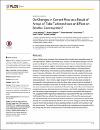Do changes in current flow as a result of arrays of tidal turbines have an effect on benthic communities?
| Author | Kregting, Louise |
| Author | Elsaesser, Bjoern |
| Author | Kennedy, Robert |
| Author | Smyth, David |
| Author | O'Carroll, Jack |
| Author | Savidge, Graham |
| Available date | 2021-09-01T10:02:41Z |
| Publication Date | 2016 |
| Publication Name | PLoS ONE |
| Resource | Scopus |
| Abstract | Arrays of tidal energy converters have the potential to provide clean renewable energy for future generations. Benthic communities may, however, be affected by changes in current speeds resulting from arrays of tidal converters located in areas characterised by strong currents. Current speed, together with bottom type and depth, strongly influence benthic community distributions; however the interaction of these factors in controlling benthic dynamics in high energy environments is poorly understood. The Strangford Lough Narrows, the location of SeaGen, the world's first single full-scale, grid-compliant tidal energy extractor, is characterised by spatially heterogenous high current flows. A hydrodynamic model was used to select a range of benthic community study sites that had median flow velocities between 1.5-2.4 m/s in a depth range of 25-30 m. 25 sites were sampled for macrobenthic community structure using drop down video survey to test the sensitivity of the distribution of benthic communities to changes in the flow field. A diverse range of species were recorded which were consistent with those for high current flow environments and corresponding to very tide-swept faunal communities in the EUNIS classification. However, over the velocity range investigated, no changes in benthic communities were observed. This suggested that the high physical disturbance associated with the high current flows in the Strangford Narrows reflected the opportunistic nature of the benthic species present with individuals being continuously and randomly affected by turbulent forces and physical damage. It is concluded that during operation, the removal of energy by marine tidal energy arrays in the far-field is unlikely to have a significant effect on benthic communities in high flow environments. The results are of major significance to developers and regulators in the tidal energy industry when considering the environmental impacts for site licences. 2016 Kregting et al. This is an open access article distributed under the terms of the Creative Commons Attribution License, which permits unrestricted use, distribution, and reproduction in any medium, provided the original author and source are credited. |
| Sponsor | The work was funded by through a Technology Strategy Board (TSB) funded project (TS10023231/1901), awarded to Graham Savidge and UK Engineering and Physical Science Research Council funding agreement (grant number EP/J010065/1), awarded to Bjoern Elsaesser. The funders had no role in the study design, data collection and analysis, decision to publish, or preparation of the manuscript. The work was funded by through a Technology Strategy Board (TSB) funded project (TS10023231/1901), awarded to Graham Savidge and UK Engineering and Physical Science Research Council funding agreement (grant number EP/J010065/1), awarded to Bjoern Elsaesser. |
| Language | en |
| Publisher | Public Library of Science |
| Subject | benthos community structure environmental impact flow rate hydrodynamics model nonhuman tidal power videorecording animal biodiversity biota ecosystem environment environmental monitoring image processing Northern Ireland physiology renewable energy sediment Animals Biodiversity Biota Ecosystem Environment Environmental Monitoring Geologic Sediments Image Processing, Computer-Assisted Northern Ireland Renewable Energy Video Recording |
| Type | Article |
| Issue Number | 8 |
| Volume Number | 11 |
Files in this item
This item appears in the following Collection(s)
-
Atmospheric Science Cluster [38 items ]


